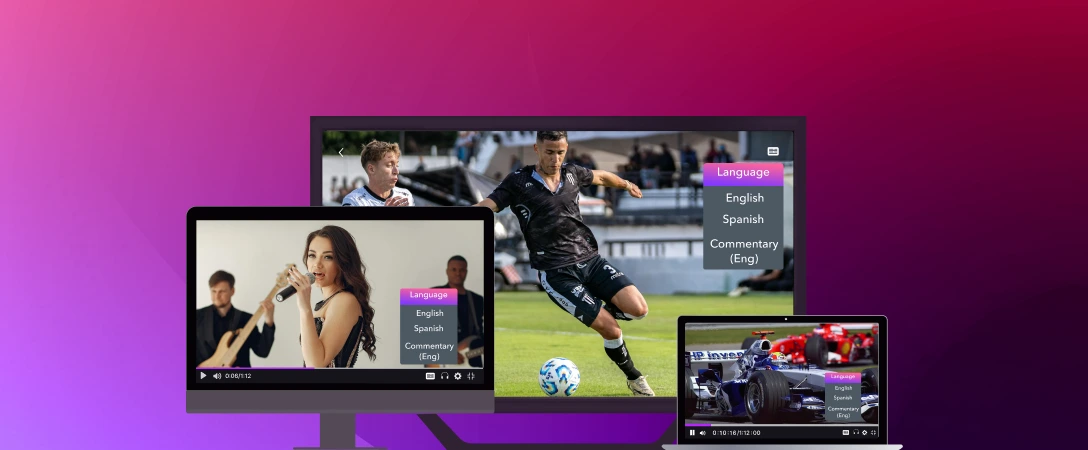55% of people watch their favorite movie or TV show online on tablet, laptop or TV every day. But what if you have to leave your comfy couch at home? The movie or show is not yet finished and you decide to continue watching on your mobile device on your way to town. We all know what comes next: The movie becomes fuzzy or very, very slow… So what happened? The answer is simple – you changed from your high bandwidth Wi-Fi connection to 3G/4G, which causes the buffering and big delays in your stream. We will explain you how Adaptive Bitrate Streaming (ABR) can reduce buffering and eliminate the biggest annoyances in online streaming and helps you watch your favorite content on the go as well.
How does adaptive bitrate streaming work?
Adaptive Bitrate Streaming (ABR) is a method to stream videos over HTTP, which makes sure that viewers will experience an optimal online video playback on all devices and at different bandwidths. It detects the available connection speed in real time and adjusts the video stream continuously to deliver the best possible picture.
To make this possible, the source video has to be encoded at different bitrates first. Those different files can then be viewed with different bitrates, that means that devices can select the speed that is appropriate to their needs. For a mobile phone this would be less than on your laptop, for instance.
The “adaptive” part in the term does basically what it says: it adapts. When a viewer starts watching a stream, the video player requests fragments from the lowest bitrate. If the player finds the download speed is greater than the bitrate of the downloaded segment, the next higher bitrate will be requested. This process goes on throughout the whole playback, so if the speed that comes to the device changes for some reason or even falls off, the player can adapt. The result is that instead of stopping or pausing the whole stream, the system will adapt and keeps playing (at a different bitrate).
This all happens behind the scenes. So, the viewer does not notice the whole switching in any way. The only thing that they could perceive is the change in quality.

How THEOplayer makes adaptive bitrate even faster to reduce buffering
Most players choose a quality just before starting a new fragment download, but this can become a problem when the download speed suddenly drops while the fragment is still downloading. In this case, the download might no longer complete in time before it is needed for playback. The new version of THEOplayer improves upon this by monitoring the download progression and continuously re-evaluating its choice. If needed, it can even stop the current download and instead download in a lower quality to ensure that the data will be available on time to be played. The challenge with this is to make an accurate estimate of the current download speed. Overestimation can lead to stalls, while underestimation causes the player to stick to a low quality for too long.
The overall goal of THEOplayer’s faster ABR is, of course, to switch faster in both directions. This means when the download speed increases, the player will switch as soon as possible to a higher quality. The opposite goes for a sudden drop in download speed which causes THEOplayer to switch to a lower quality to ensure that the playback continues smoothly. The online video experience of your viewers will be more immersive and not be hampered by any interruption, buffering or a slow startup time.
How you and your viewers can benefit from faster adaptive bitrate
With the internet connection becoming faster and faster during the last years, the patience of users has gone into the opposite direction. Viewers perceive the biggest annoyances during online streaming as slow startup time, buffering, pixels or a fuzzy picture. A study carried out by Conviva revealed that 1 in 4 viewers experiencing a poor video will quit in less than 4 minutes.
Delivering a great online video to your viewer can be done using ABR. It easily becomes the most optimal experience with faster ABR. Your viewers will not have to deal with buffering anymore. They will be able to start the video stream quickly and keep watching a smooth online stream. Be it on Wi-Fi or 3G/4G, they will always be able to enjoy their most favorite content from your servers and the superior experience.
Faster ABR enables online publishers and broadcasters to deliver high quality video without big effort. Due to a great flexibility, the played quality automatically adjusts to the environment, network connectivity, screen size, etc.
[OTT viewers] Develop negative brand impressions of services providing a poor experience quickly, with two in five reducing their affinity for a service based on a single negative experience. – Conviva
So make sure to pull out all the stops that prevent your audience from enjoying an optimal online video experience. The easiest step to reduce streaming problems is to choose a video player with fast ABR support.







